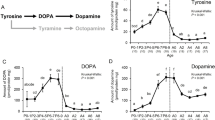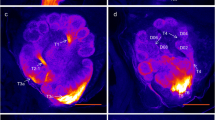Abstract
Neuron activity was studied electrophysiologically in the antennal lobes, mushroom bodies, and cervical connective during ontogenesis (days 1, 3, 7, and 25) in snowlaranija mutant bees, which suffer kynurenine deficiency, and in wild-type bees. Neuron activity recorded from the cervical connective was found to show the greatest dependence on kynurenine content. Mutation in the structural gene for tryptophan oxygenase, the first and key enzyme in the kynurenine pathway for tryptophan metabolism (KPTM) and which leads to kynurenine deficiency, decreased the frequency of neuron spike activity recorded from the cervical connective. This would appear to be associated with a possible deficiency of glutamic acid; it was independent of the deficiency of kynurenic acid and kynurenine, a point subject to further studies. Clear manifestation of the effect of the mutation requires the presence of two mutant alleles in the bee genome (homozygosity). The effect of the mutation, to inhibit neuron activity in the cerebral ganglion, corresponds to the effect seen previously at the behavioral level. Less clear effects were obtained from recordings of neuron activity from the antennal lobes and mushroom bodies. This may be associated with the complexity of the spectrum of biochemical lesions in different parts of the brain resulting from the mutation.
Similar content being viewed by others
REFERENCES
P. A. Kometiani, “The effects of changes in the distribution of free amino acids, monoamines, and cyclic adenylic acid(3′5′-cAMP) in the brain on its functional activity,” in: Mechanisms of Memory [in Russian], Nauka, Leningrad (1976), pp. 144–157.
N. G. Lopatina, L. F. Dmitrieva, V. V. Ponomarenko, and R. G. Chesnokova, “The snow gene in the control of nervous system function and behavior in honey bees (Apis mellifera),” Genetika, 30, No. 1, 141–144 (1994).
N. G. Lopatina, E. G. Chesnokova, and V. V. Ponomarenko, “Tryptophan and its metabolites in nervous system function and behavior in the bee Apis mellifera,” Zh. Evolyuts. Biokhim. Fiziol., 21, No. 1, 25–32 (1985).
V. B. Smirnov and V. V. Ponomarenko, “The effects of mutations blocking the kynurenine pathway of tryptophan metabolism on neuronal activity in Drosophila melanogaster,” Dokl. Akad. Nauk SSSR, 258, No. 2, 489–491 (1981).
“Learning and memory in honeybees: from behavior to neural substrates,” Ann. Rev. Neurosci., 2, 372–404 (1996).
Author information
Authors and Affiliations
Additional information
__________
Translated from Zhurnal Vysshei Nervnoi Deyatel'nosti imeni I. P. Pavlova, Vol. 54, No. 6, pp. 806–809, November–December, 2004.
Rights and permissions
About this article
Cite this article
Smirnov, V.B., Chesnokova, E.G., Lopatina, N.G. et al. Characteristics of Neuron Activity in the Honey Bee (Apis Mellifera L.) in Conditions of Kynurenine Deficiency. Neurosci Behav Physiol 36, 213–216 (2006). https://doi.org/10.1007/s11055-006-0002-3
Received:
Accepted:
Issue Date:
DOI: https://doi.org/10.1007/s11055-006-0002-3




